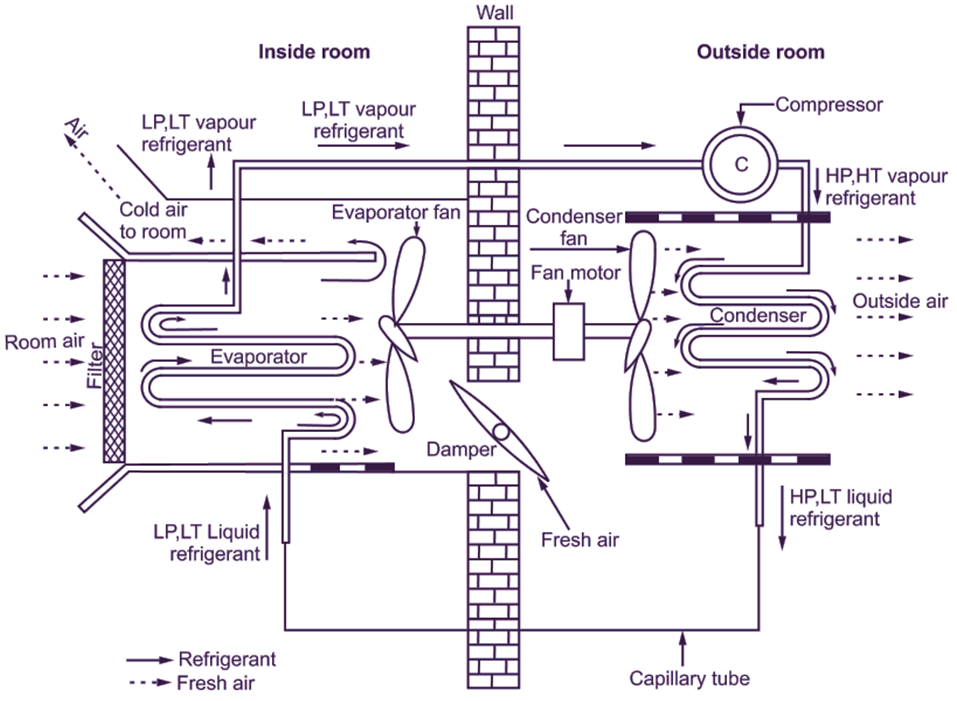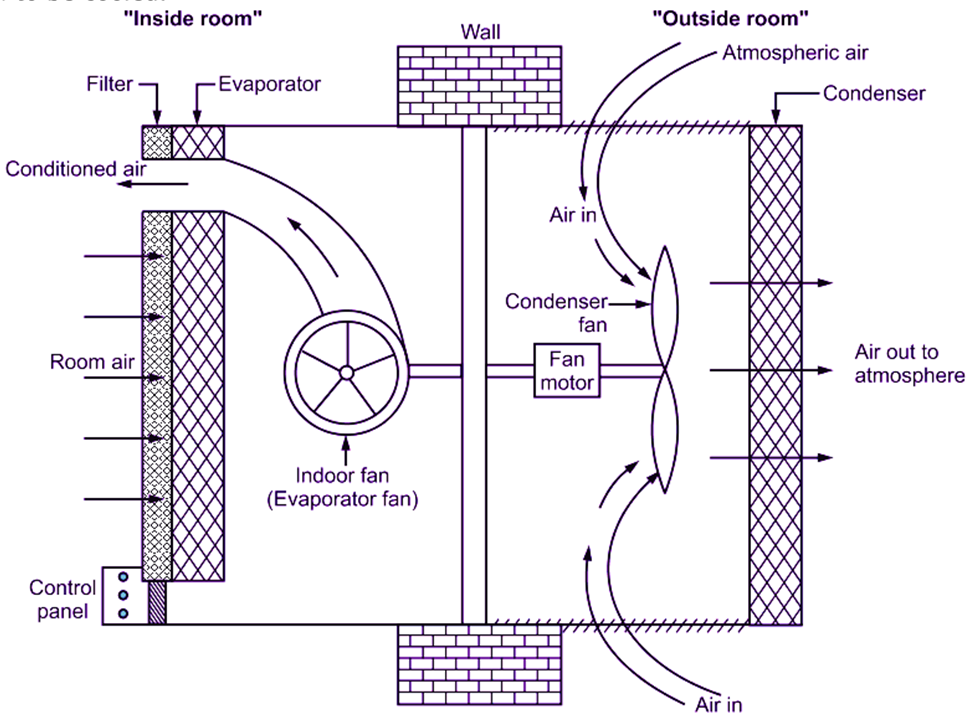Window air conditioner is a small unit having capacity of 1/2 TOR to 3 TOR. Window air conditioner is a room air conditioner mounted in a window, through a wall.
Working Cycle: Vapour compression cycle.
Construction of Window Air Conditioning System

Fig. 1 Window air conditioner.
Window air conditioning system consists of following components:
- Compressor,
- Expansion device (i.e. Capillary tube),
- Air Filter.
- Condenser,
- Evaporator,
- Controls.
Al the above mentioned components are briefly discussed in the following manner. Window air conditioning system consists of following components:
Compressor
It is of hermetically sealed type compressor. This type of compressor has its motor and all moving parts operating within a sealed gas tight housng.
Condenser
It is air cooled type condenser having continuous coil of copper tubing, to which, aluminium fins are attached to increase surface area, through which, more heat transfer can take place. A propeller type fan is located immediately in front of condenser to cool the condenser coil.
Expansion Device (Capillary tube)
Capillary tube is the most commonly used expansion device in window air conditioner. It is a tube of very small diameter and long length. Its function is to reduce the pressure of high pressure, low temperature liquid refrigerant coming from condenser and convert it Into low pressure, low temperature liquid refrigerant. In short, it creates pressure drop, when liquid refrigerant is passed through it.
Evaporator
It is located at the front end of room air conditioner. It is also made up of copper tubing, like condenser coils. Evaporator is surrounded by insulating material, such that, it reduces operating noise. A propel er type fan is located in front of evaporator, so that, it can pul the fresh air from outside through ventilation dampers. The fresh air mixes with room air together and is passed over evaporator coil.
Air Filter
Air should be fltered, as soon as, it enters the air conditioner. In a window air conditioner, air filter is located on the air entering side of evaporator coil. Either permanent or replaceable filters are used.
Controls
Window air conditioner is provided with two controls:
(a) Master control
It controls the compressor, compressor motor, condenser fan motor and evaporator fan motor. When switch is on cool position, all motors operate and complete unit works as air conditioning unit.
(b) Thermostat control
It is located in return air path near filter. It is used to ensure desired temperature conditions inside the room.
Operation of Window Air Conditioning System
High pressure, high temperature vapour refrigerant coming out of compressor is condensed in condenser using outside (atmospheric) air as cooling medium. The liquid refrigerant is further passed through capillary tube to reduce its own pressure and then passed over evaporator, where it absorbs heat from air to cool it. Due to absorption of heat, the liquid refrigerant gets converted into vapour refrigerant and these vapours are drawn into the compressor and cycle is repeated again and again.
Air Circuit of Window Air Conditioning System
The function of window air conditioner is to provide comfort to the occupants in the room by,
- Cleaning the air,
- Dehumidifying the air, and
- Cooling the air,
- Distributing the air to each and every corner of room.
Window air conditioning system does not require ducts for free delivery of conditioned air into room to be cooled.

Fig. 2: Air circuit of Window air conditioner
The air circuit of a window air conditioner consists of 3 major air circulation systems.
Room air
The air from the room is drawn over the evaporator fan (also called as indoor fan) through a filter, which removes dirt, dust, impurities etc. The fan used may be propeller type or centrifugal type. The air is cooled while passing over the evaporator tubes by giving its heat to the refrigerant circulating inside the evaporator. A thermostat (in control panel) is provided at the evaporator to measure the temperature of air coming from the room. If the temperature is above the set or desired value, it makes the compressor to switch “ON”. If the temperature is below the set value or desired value, it makes the compressor to switch “OFF”.
Outside air
The outside (atmospheric) is drawn over the condenser fan. The vapour refrigerant circulating inside the condenser coil gives up its heat to the air and gets condensed and cooled. The fan used here is of propeller type.
Fresh air from outside
To maintain the purity of air inside the room, fresh outdoor air is made to enter into the room through air damper. The fresh air is cooled by evaporator coils, while coming from damper. This cooled fresh air is then mixed With the room air.
Note: For driving the condenser fan and evaporator fan, either the same motor or different motors can be used.